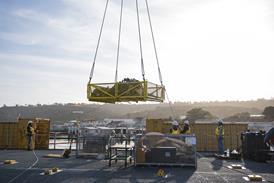Tim Furniss/LONDON

The NASA panel investigating the loss of the $327 million Mars Climate Orbiter (MCO) has uncovered a potential problem with the Mars Polar Lander (MPL), which is due to touch down on 3 December.
NASA has found that temperatures as low as -20°C could affect the performance of the spacecraft's descent engine, which is a new pulse unit that has never been used for a Mars landing.
The engine is scheduled to ignite 2km above the surface, as the craft aims for a landing site on the edge of the Martian South Pole 40s later. The MPL engine will use series of thrusters to perform a controlled landing.
Propellant heaters will be turned on several hours before the firing to increase the engine temperature to 8íC. It has also been reported that the system which will be used to separate the MPL from its aeroshell atmospheric entry shield was installed without heaters. It is not known whether they will work properly either. The MCO loss investigation team has uncovered a catalogue of problems which contributed to the orbiter's loss.
The MCO crashed on Mars on 23 September following a mix-up in the use of metric and imperial measures for the approach to the planet. The loss investigation team's findings reveal that there was inadequate training and the staff was overworked.
This contributed to an undetected mismodelling of velocity changes, a navigation team unfamiliar with the spacecraft, a trajectory manoeuvre not performed and poor systems engineering.
The team also highlights inadequacies in communications between project teams, navigation team staffing, training, and verification and validation processing.
Wide-ranging managerial and technical actions are under way at NASA's Jet Propulsion Laboratory following the investigation.
Meanwhile, planetary scientists have selected two candidate sites in the Isidis and Hematite regions of Mars, close to the planet's equator, for the landing of the Mars Surveyor 2001 craft.
The NASA Mars Surveyor mission was originally planned to deploy the long-range Athena rover to collect samples which would be returned to Earth on a later mission.
This programme, which was scaled down due to budget cuts in 1998, will now involve a short-range mini-rover called Marie Curie. It will be almost identical to the Sojourner which landed on Mars in 1997 as part of the Mars Pathfinder mission.
Mars Surveyor 2001 will also conduct a basic assessment feasibility test of manufacturing rocket propellant from constituents in the Martian atmosphere and will carry a set of experiments to gauge potential physical dangers on the planet's surface.
Source: Flight International























